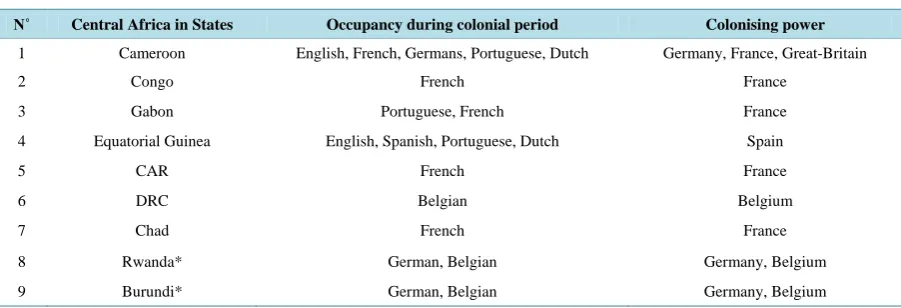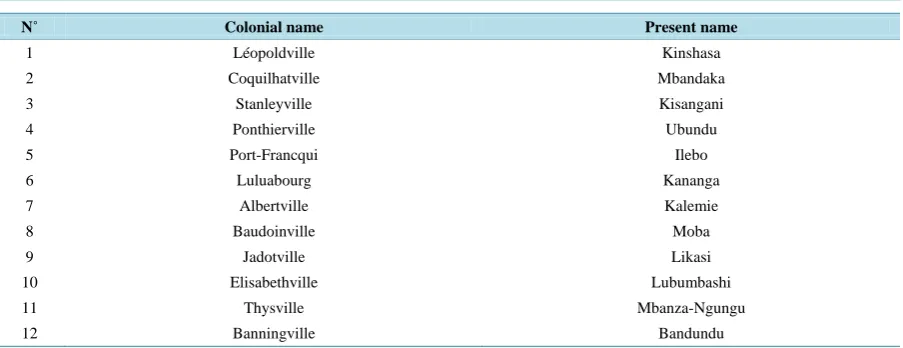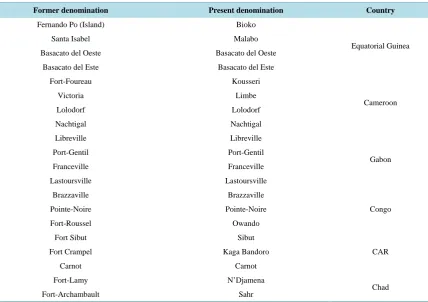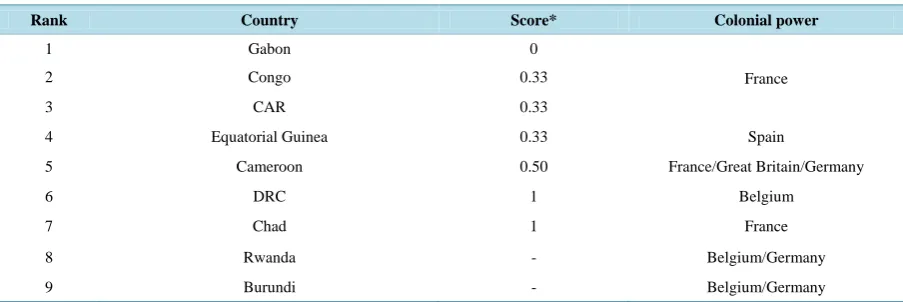How to cite this paper: Simeu-Kamdem, M. and Koulbout, D. (2016) Some Features of Urban Place Names in Central Africa.
Open Access Library Journal, 3: e2914. http://dx.doi.org/10.4236/oalib.1102914
Some Features of Urban Place Names in
Central Africa
Michel Simeu-Kamdem, David Koulbout
National Institute of Cartography, The Central African Division of the United Nations Group of Experts on Geographic Names (UNGEGN)
Received 20 July 2016; accepted 27 August 2016; published 31 August 2016
Copyright © 2016 by authors and OALib.
This work is licensed under the Creative Commons Attribution International License (CC BY).
http://creativecommons.org/licenses/by/4.0/
Abstract
More than fifty years after African countries independence, the colonial system continues to reveal its heritage. This is particularly true with urban place names among which a number of currently used are of colonial origin. Through a number of readings, the authors analyze the present situa-tion in Central Africaand question its meaning. The article provides therefore an understanding of urban geographical names in nine countries colonized by French, Germans, British, Belgians and Spaniards. It appears that if Belgium was the colonial power that gave most of its place names to towns in Central Africa, it has been, after the independence, the only country that experienced a total decolonization of urban geographical names. In addition, the heterogeneity of the current urban toponymic situation lays, both on the contrasting profile of the colonial powers and on the different reactions of the colonized countries after independence.
Keywords
Urban Place Names, Colonization, Independence, Central African Countries
Subject Areas: History, Sociology
1. Introduction
OALibJ | DOI:10.4236/oalib.1102914 2 August 2016 | Volume 3 | e2914 the way for the decolonization of the names of places. Countries such as the Belgian Congo, Dahomey, Upper Volta, the Gold Coast, seized this opportunity to change names.
Central Africa on its part experienced one after another and/or simultaneously British, Spanish, German, Por-tuguese, Dutch, Belgian and French occupations. Concretely, the British occupied Cameroon and Equatorial Guinea; the Belgians, the DRC, Rwanda and Burundi; the Spaniards, Equatorial Guinea; Germans, Cameroon, Rwanda and Burundi; the Dutch and the Portuguese, Equatorial Guinea and Cameroon; and the French occupied Chad, Gabon, Congo and Cameroon. While most currently used urban names are of African origin, the fact re-mains that some that were borrowed from the colonialists still exist or were simply renamed. Therefore, one can question the meaning of the current situation of urban place names in the region.
2. A Region Colonized by Several European Powers
In the colonial enterprise, several European powers have occupied Central Africa. Indeed, before the promulga-tion of the “General Act” of the Congress of Berlin on February 23, 1885 (R. and M. Cornevin, 1974, p. 300 [1]), recognizing among others the freedom of navigation on the Niger and Congo, freedom of trade in the Congo ba-sin, the German doctrine of the “Hinterland”, seven colonial powers jostled in the region. To the eternal An-glo-French rivalries were added in this theater, the Germans, the Belgians, the Portuguese, and the Dutch, as shown in the following table (Table 1).
It goes without saying that among the various European competitors, the conference devoted the prize to po-werful countries (Germany, France, England), but also to strategists (Belgium). It is for this reasons that only France, Germany, Belgium, Spain and Britain will manage to settle permanently in the countries of the region. Defeated in the two wars, Germany will lose all its rights in the territories of Central Africa (Cameroon, Rwanda and Burundi).
3. Urban Place Names with Colonial Connotation in Consequence
If we refer to cartographic works carried out during the colonial period by government agencies as well as by private institutions, it is clear that all the countries of the region had place names of foreign origin. An inventory can show the situation for each of the nine countries.
Although most names have local origins in Equatorial Guinea, some important places still bear names that are of colonial origin. This is the case of Fernando Po for the island that houses the capital, the latter itself known as Santa Isabel. Other smaller localities bear names of the language of the colonizer. These are Basacato del Oeste in the west of the island of Fernando Po and Basacato del Este, in the north-east of the island.
[image:2.595.88.539.553.707.2]In countries that have experienced a quasi French monopolistic colonization (Gabon, Congo, Central African Republic and Chad), the names of important cities were all of colonial origin. This is the case for Gabon, with Libreville, Port Gentil, Lastoursville and Franceville. Except for Lastoursville, these three towns are today the country’s largest urban areas (political capital, economic capital and provincial capital). In Congo, the situation is almost similar with place names of French origin to denote the main cities of the country. Brazzaville, the
Table 1. Distribution of countries in Central Africa according to occupancy during the colonial period.
N˚ Central Africa in States Occupancy during colonial period Colonising power 1 Cameroon English, French, Germans, Portuguese, Dutch Germany, France, Great-Britain
2 Congo French France
3 Gabon Portuguese, French France
4 Equatorial Guinea English, Spanish, Portuguese, Dutch Spain
5 CAR French France
6 DRC Belgian Belgium
7 Chad French France
8 Rwanda* German, Belgian Germany, Belgium
9 Burundi* German, Belgian Germany, Belgium
OALibJ | DOI:10.4236/oalib.1102914 3 August 2016 | Volume 3 | e2914 former capital of French Equatorial Africa (FEA) is today, with over a million inhabitants, the political capital and largest city of Congo. Pointe-Noire on the Atlantic coast is the main gateway to the country. Further north, Fort Roussel appears much more modest. The Central African Republic experienced but much less markedly, the same phenomenon. If the place name for Bangui, the name of the capital of the CAR is not of European ori-gin, a number of localities have foreign names. One can cite amongst others, Carnot, Fort Sibut and Fort Cram-pel respectively in the west and north of Bangui. In Chad, the most famous towns were named Fort Lamy and Fort Archambault.
In Cameroon, the names of European origin were rare. They are limited to Victoria (British) on the Atlantic coast, Lolodorf on the western edge of the southern Cameroon plateau and Nachtigal, a village in Lékie Division along the Sanaga River (German), and Fort Foureau (French) in Far North. Although Nachtigal is still a village, it is a renowned place in Cameroun because of its waterfalls on the Sanaga River, discovered at the end of the 19th century by a German named Gustav Nachtigal [2]. These places remained even today much smaller locali-ties.
The Democratic Republic of Congo was not spared by the fashion of European names. On the contrary, the phenomenon seems to be accentuated, judging by the number of concerned entities. Examples that command at-tention include Leopoldville (the capital), Coquilhatville (north-west of DRC), Stanleyville and Ponthierville (in the north), Port Francqui (in the centre), Luluabourg (in the south-west), Albertville, Baudoinville, Jadotville and Elizabethville (in the east and southeast). This is, as we can see, localities whose importance in the political, economic or strategic spheres is no longer in doubt. The situation of Rwanda and Burundi can be singled out as no colonial urban place names were identified. The complete situation of the region can be seen on the following table (Table 2).
Beyond the presentation of urban place names by country, it may be more interesting to see for the different countries, the origin of the colonizer (Table 3).
[image:3.595.86.542.447.536.2]This table highlights the specificity of certain countries like Cameroon where three colonizing powers suc-ceeded in giving each only one place name in the country, or as the Belgian Congo, where the names of the ma-jor cities are mainly of Belgian origin. The situation of Rwanda and Burundi, who have no place name of co-lonial origin, is also rather paradoxical given that Belgium was the coco-lonial power that gave most of its place names to towns in Central Africa.
Table 2. Proportion of foreign urban place names in Central Africa during the colonial period.
Less than 3 towns 3 - 5 towns More than 5 towns
Chad Cameroon DRC
Rwanda Congo
Burundi Gabon
Equatorial Guinea
CAR
[image:3.595.86.536.573.706.2]Source: Personal investigations.
Table 3. Proportion of foreign place names and origin of the colonizing country.
Less than 3 towns 3 - 5 towns More than 5 towns
French in Cameroon French in Congo Belgians in DRC
Germans in Cameroon French in Gabon
English in Cameroon CAR
Germans in Rwanda Spaniards in Equatorial Guinea
Germans in Burundi
Belgians in Rwanda
Belgians in Burundi
French in Chad
OALibJ | DOI:10.4236/oalib.1102914 4 August 2016 | Volume 3 | e2914
4. The Turning Point of the Years of Independence
The independence of the countries of Central Africa was not only political. It resulted in the questioning of a number of achievements in various fields. Culturally, it resulted to the revisit of the toponymic legacy of the co-lonizers, especially in the naming of urban entities. This phenomenon which is part of a standardization of the names of places framework before the letter, has not taken the same meaning for all countries. The standardiza-tion of place names was recommended at the 1st UNGEGN Conference held in New York in 1967. As H. Ker-foot mentioned, “Field collection of names was establish as an important principle, and one that certainly recog-nized the importance of toponyms to local populations and the significance of recognizing these name as part of a national tradition” [3]-[7]. While some have imposed the renaming of the names of the provinces and urban entities according to the written language of the colonizer, others remained indifferent.
In Equatorial Guinea, Fernando Po, the island that houses the capital and Santa Isabel, the capital itself today bear the names of Bioko and Malabo respectively. The names of Spanish origin that were also not many during the colonial period are now limited to the two small towns of Basacato located in the east and west of Malabo.
In countries that remained largely under French colonial rule, two attitudes can be noted: that of countries which have completely or nearly eliminated foreign names in the denomination of their towns like the CAR and Chad. If in Chad, the two main towns, that is, Fort Lamy and Fort Archambault were replaced by N’Djamena and Sahr, in the CAR, Fort Sibut became Sibut, and Fort Crampel was renamed Kaga Bandoro. Carnot has not changed its name. The other attitude is that of countries that have remained indifferent like Congo and Gabon. These two countries have maintained virtually most of the names written in the language of the colonizer. Fort Roussel becoming Owando, is however the exception in Congo.
The situation in Cameroon is quite peculiar. Despite the presence of three colonial powers, this country had few names of foreign origin. In all, only four were discovered and these are respectively in the French (Fort Foureau), English (Victoria) and German languages (Lolodorf and Nachtigal). The changes with time have transformed only the first two into Kousseri and Limbe.
The Democratic Republic of Congo has experienced in this field, more than in the other countries a true rev-olution. No location has been spared from the dozens of cities whose names were of colonial origin, as shown in the following table (Table 4).
Here, it is a real decolonization of names. A summary of the current situation of urban place names in the other countries of Central Africa is presented in the table below (Table 5).
[image:4.595.89.541.533.707.2]Place names identify and reflect culture, heritage and landscape. As UNGEGN underlines, they provide bene-fits to local, national and international communities (UNGEGN Brochure, 2001). When we know that geo-graphical names are an important source of knowledge of the past and conservation of the memory of peoples that must be preserved, when we know that they are a spatial marker of the culture of peoples who occupied a given space, it may be interesting to try to understand the factors explaining the heterogeneity of the current to-ponymic situation.
Table 4. Transformation of the names in the DRC.
N˚ Colonial name Present name
1 Léopoldville Kinshasa
2 Coquilhatville Mbandaka
3 Stanleyville Kisangani
4 Ponthierville Ubundu
5 Port-Francqui Ilebo
6 Luluabourg Kananga
7 Albertville Kalemie
8 Baudoinville Moba
9 Jadotville Likasi
10 Elisabethville Lubumbashi
11 Thysville Mbanza-Ngungu
12 Banningville Bandundu
OALibJ | DOI:10.4236/oalib.1102914 5 August 2016 | Volume 3 | e2914
Table 5. Current status of urban place names in other countries of Central Africa.
Former denomination Present denomination Country
Fernando Po (Island) Bioko
Equatorial Guinea
Santa Isabel Malabo
Basacato del Oeste Basacato del Oeste
Basacato del Este Basacato del Este
Fort-Foureau Kousseri
Cameroon
Victoria Limbe
Lolodorf Lolodorf
Nachtigal Nachtigal
Libreville Libreville
Gabon
Port-Gentil Port-Gentil
Franceville Franceville
Lastoursville Lastoursville
Brazzaville Brazzaville
Congo
Pointe-Noire Pointe-Noire
Fort-Roussel Owando
Fort Sibut Sibut
CAR
Fort Crampel Kaga Bandoro
Carnot Carnot
Fort-Lamy N’Djamena
Chad
Fort-Archambault Sahr
Source: Personal investigations.
5. Tentative Explanation of the Heterogeneity of Urban Toponymic Situation
Inherited from Colonization
How do we explain today the differential levels of flirtations with colonial urban place names? This can be ana-lyzed from different angles, but we will retain two:
*An investigation of the situation and the specificities of the colonizers; *A quick review of the position of the colonized countries.
5.1. The Contrasting Profile of the Colonial Powers
We have noted (Table 1), that five European powers finally colonized Central Africa. These are France, Britain, Germany, Spain and Belgium. After the ousted of Germany following its defeat in the two world wars, only four remained. France controls four countries and shares a fifth with Britain, Belgium controls three and Spain one.
In French Equatorial Africa (FEA), not to be confused with Central Africa, which in itself is much wider; France controlled wholeheartedly Gabon, Congo, Chad and the CAR. In this group of countries, Gabon, by its geographical position on the coast seems more “interesting” in a lesser extent than Chad and the CAR which are further inland. This may be explained by the amount of affection for the former than for the latter and which would result in the number of urban place names used in different countries. The introduction of French place names in its colonies is explained by the fact that France had never seriously considered parting way with it. In Cameroon, France had inherited, like Great Britain, the German protectorate over the country. This situation did not give it the same freedom or the same scope as in other territories of the FEA and this probably explains the weak influence of names of French origin.
Spain, colonial ruler of Equatorial Guinea, had in heart too, to forever mark its footprint by the use of Spanish names. The fact that it bought the islands of Fernando Po and Annobon, from Portugal clearly indicates its wil-lingness to settle a long time. The use of Spanish names in these conditions appears to be purely logical.
be-OALibJ | DOI:10.4236/oalib.1102914 6 August 2016 | Volume 3 | e2914 tween the major powers (France, Britain, Germany and Portugal) to found a “personal” empire several times larger than Belgium (Cornevin, 1974 [1]). The proliferation of Belgian names in this empire indicated neither more nor less, the determination to quickly own this territory and so deter other great powers from looking at it. This attitude however contrasts sharply with the total absence of Belgian urban place names in Rwanda and Bu-rundi where the Kingdom of Belgium successively held mandatory power and tutelary functions. Perhaps we must admit that in this different context, the Belgians did not have the same enthusiasm as in their Congo.
In Central Africa, Britain had inherited with France, only a German protectorate over Cameroon. On a rela-tively small territory, this British administration constituted only a small challenge for the crown compared to its West, North, East or South African territories. One understands easily why only one town, Victoria, had an Eng-lish place name in Cameroon. It should however be noted that in general, the EngEng-lish are less likely than the French, to use British urban place names.
The situation of the Germans in this table is rather special. Although having arrived late in the colonial com-petition (almost like the Belgians), they will quickly occupy a non negligible portion of the territory of Central Africa, this according to their doctrine of “Hinterland” which states that the occupation of the coast assures the exploitation of the hinterland (Cornevin, 1974 [1]). Thus, they set up their first ever counters in Douala in 1868, ensuring control over Cameroon and later signed treaties with tribal leaders near Zanzibar, ensuring therefore their progress in what will be called German East Africa. The loss of their possessions after the two wars may explain the absence or the low proportion of urban place names of German origin in the occupied countries. Cameroon, Rwanda and Burundi are palpable illustrations. If apart from Central Africa, Togo has, almost the same features as Cameroon on this point, in Namibia, paradoxically we find several German names. About half a dozen of them can be illustrated. Amongst these we have Grootfontein north, Karasburg and Seeheim south, southwest Lüderitz and Mariental center [8]-[10].
5.2. Divergent Reactions of the Colonized Countries after Independence
The review of the position of the colonized country can be relevant only after independence, as it is true that be-fore they could hardly speak as national territorial entity and therebe-fore united and strong within recognized bor-ders. Several behaviors can thus be analyzed immediately after the accession of different countries to indepen-dence (Table 6).
[image:6.595.87.539.558.709.2]The situation ranged from countries that did not in any way modify their urban place names of colonial origin after independence, to those that changed everything. To be more precise, one country, that is Gabon, a former French colony, has maintained all urban place names inherited from the colonial period. This may be as a result of the fact that in this country, there exists the willingness to continue and perpetuate, something which began some $decades ago. That is, foreign geographical names are, in fact, considered as part of the national history. They are the nation’s cultural heritage and, as Sungjae Choo underlines, “Each place name has its one raison d’être in that it was created by name giver’s perception of identity of the place (Sungjae Choo, 2015 [11]). As they represent a memory of places, as they provide information about natural and cultural conditions at the time they were created, they therefore have a cultural value (Helleland, 2006: 121 [12]), and express the identity of a
Table 6. Situation of urban place names of colonised countries after independence.
Rank Country Score* Colonial power
1 Gabon 0
France
2 Congo 0.33
3 CAR 0.33
4 Equatorial Guinea 0.33 Spain
5 Cameroon 0.50 France/Great Britain/Germany
6 DRC 1 Belgium
7 Chad 1 France
8 Rwanda - Belgium/Germany
9 Burundi - Belgium/Germany
OALibJ | DOI:10.4236/oalib.1102914 7 August 2016 | Volume 3 | e2914 people. Another reason explaining the link between geographical names and a nation’s cultural heritage is that they are part of the local languageand history. They also represent a link between communities and their envi-ronment. This is why they must be preserved.
Gabon is followed in this hierarchy by Congo, another French colony. This second place is shared with the CAR and Equatorial Guinea. In the fifth place is Cameroon which amended two names out of four. In any case, the intermediate position of these countries reflects the reluctance to definitively break-away with the old co-lonial powers and to end with the past.
In contrast, two countries, Chad and the DRC have renamed all their urban place names that they got from the colonial period. In the DRC in particular, the process seemed to be a real toponymic decolonization. Though in Chad this change affected only two localities, it undoubtedly reflects a desire to change things, to break-away with the past and move on. Of course, Rwanda and Burundi, not concerned by these place names of colonial origin are not included in the analysis.
6. Conclusion
The fact that Central Africa was colonized by several European powers, led to the utilization of urban place names of foreign origin in this region. This usage was highly variable; that is from one colonizer to another, and from one country to another, especially because of the specificity of the former but also to the reaction of the latter, especially when independence was achieved. In fact, after achieving independence, contrasting attitudes were revealed. In countries that experienced several occupations like Cameroon, the phenomenon was limited in scope, and did not attract particular attention. Those countries that remained largely under French influence had two attitudes: that of countries that have completely changed the names of major towns to native names, like Chad and those countries that have remained indifferent to this situation (Gabon, Congo, and CAR). Even Equatorial Guinea seems to be well accustomed to the situation. Conversely, the DRC, colonized by Belgium showed a particular enthusiasm to rename all its urban place names of colonial origin. Should we see through this, particular predisposition to the mutations of various kinds which continually challenge Africa? There is another topic for discussion.
References
[1] Cornevin, R. et M. (1974) History of Africa, from Origin to the 2nd World War. 4th Edition, Payot, Paris.
[2] Maiyamooh, F.B. (2016) The Nachtigal Fall and the Development of Tourism in Batchenga, Cameroon. DIPES II Dis-sertation, ENS, University of Yaoundé 1.
[3] GENUNG (2007) Geographical Names as Vital Key for Access to Geographic Information in Our Globalized and Dig-ital World. GENUNG, New York.
[4] Helen, K. (2015) Tracing UNGEGN’s Evolving Interest in Geographical Names as Cultural Heritage. In: Choo, S., Ed.,
Geographical Names as Cultural Heritage, Proceedings of the International Symposium on Toponymy, Seoul, Kyung Hee University Press, 17.
[5] United Nations (2001) Benefits of Consistent Place Naming around the World. UNGEGN Brochure, Department of Economic and Social Affairs Statistics Division, New York.
[6] United Nations (2002) Glossary of Terms for Geographical Names Standardization. United Nations, New York. http://unstats.un.org/unsd/geoinfo/glossary_add.htm
[7] Mashini, C. and Mbuyi Mucici, P. (2011) The Use of Geographical Names in DR of Congo: Towards the Need for Standardization. Communication Presented at the 26th Session of UNGEGN, Vienna.
[8] French General Bookshop (1969) Paperback Atlas. New Edition, Paperback Edition, Prague.
[9] Dorion, H. and Poirier, J. (1975) Glossary of Useful Terms for Place Names. Choronoma/6, Laval University Press.
[10] Serryn, P. and Blasselle, R. (1982) Dictionary of States. Bordas, Vol. 4.
[11] Choo, S. (2015) Geographical Names as Cultural Heritage. Proceedings of the International Symposium on Toponymy, Kyung Hee University Press, Seoul.
Submit or recommend next manuscript to OALib Journal and we will provide best service for you:
Publication frequency: Monthly
9 subject areas of science, technology and medicine
Fair and rigorous peer-review system
Fast publication process
Article promotion in various social networking sites (LinkedIn, Facebook, Twitter, etc.)
Maximum dissemination of your research work
Submit Your Paper Online: Click Here to Submit




